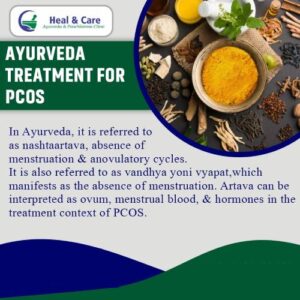Introduction
One of the fastest-growing diseases that affect the female in the reproductive age group is a polycystic ovarian syndrome. The global prevalence is almost 5-10% and is about 52% in India. PCOS is a hormonal disorder accompanied by irregular periods & excess male androgen hormone levels. The menstrual cycle can be either prolonged, infrequent, excessive, or scanty. The ovary gets collected with fluids & there is a failure to release the egg. Gradually the ovaries are enlarged & release estrogen & androgens. This hormonal imbalance interferes with the release of eggs & cause irregular menstruation.
Symptoms
Irregular periods
Irregular prolonged, infrequent menstrual cycles are the commonest signs of this disease. It can be heavy periods or less than 9 cycles a year or the duration between 2 cycles will be more than 35 days.
Androgen in excess shows symptoms like baldness of male pattern, body & facial hair growth, in some cases there are acne as well as pigmentations.
The presence of polycystic ovaries is one of the cardinal signs. There is an enlargement of ovaries & follicles around eggs.
Metabolic dysfunctions such as weight gain, hypothyroidism with high cholesterol levels.
For an obese person, the symptoms are more intense & also may be accompanied by excessive lethargy as well as fatigue.
Causes – The actual cause is still unknown
Excess insulin- Insulin can decrease blood sugar by enabling the cells to utilize sugar. If the cells exhibit insulin resistance, then the blood sugar rises & insulin levels continue to increase. This excess insulin enhances the androgen hormone production which hinders the ovulation process
Heredity is seen as a cause from many research studies
Excess androgen production by the ovaries causes acne & excess hair growth.
 Ayurveda treatment for PCOS
Ayurveda treatment for PCOS
Perspective
In Ayurveda, it is referred to as nashtaartava, absence of menstruation & anovulatory cycles. It is also referred to as vandhya yoni vyapat, which manifests as the absence of menstruation. Artava can be interpreted as ovum, menstrual blood, & hormones in the treatment context of PCOS.
Ayurveda treatment is designed based on avoiding the cause & symptomatology. The most common symptoms are irregular menstruation androgen hormonal problems & infertility. This where Ayurveda stands out inimitable in managing PCOS. Avoiding the causes, Nidana parivarjana is the primary line of intervention. An unhealthy diet & regimen should be avoided. Particularly, the junk foods like burgers, pizza, fries, & oily snacks. Also, carbonated drinks, any type of gaseous drinks, bottled drinks, processed foods like sausages, canned foods, precooked foods should be completely avoided. Following a sedentary lifestyle without proper physical activity, excess sleep, or absence of sleep can contribute to metabolic disturbances & cyst formation in the ovary.
The menstrual channels are obstructed by the Vata & Kapha dosha owing to the unhealthy health & regimen. This gradually results in absence of menstruation.
In such a situation the general line of treatment should be a daily exercise, yoga asanas, pranayama& meditation.
The Panchakarma therapy for PCOS
As for any disease in extreme cases, samshodhana therapy or detoxification therapy has to be done to eliminate the accumulated toxins from the body. It also clears the channels of menstruation, if there is any obstruction. The purificatory therapy can be either through the upward direction or the downward direction. In some classical contexts, emesis therapy is best recommended. It eliminates the Kapha bhava from the body & aids in boosting metabolism. Whereas the purgation or defecation therapy Virechana reduces the pitta dosha, which in turn reduces the menstruation. Blood & pitta dosha has similar qualities. Hence virechana therapy is not recommended here. The Vamana therapy increases the agneya qualities in the body, hence promotes normal menstruation. In some circumstances, depending upon the clinical symptoms, either of the therapies can be chosen, especially in cases of excess bleeding.
Intake of agneya drugs or pitta increasing drugs is found effective to restore normal menstruation. The drugs are hot in potency & maintain the quality of the blood. It helps to clear the obstruction caused by Vata & Kapha & initiate the normal flow of menstrual blood.
Use of svayoni vardhana dravya
In Ayurveda, there are specific medicines for increasing the menstrual blood. Tila, kulattha are some among them. The herbs increase the quantity of menstrual blood as they possess similar qualities.
Classical formulations
Varanadi kashayam– decreases Vata -Kapha vitiation stimulates the metabolic reactions.
Rajah pravrttini vati – It promotes normal menstruation & maintains the quality of blood.
Arogya vardhini Vati – General wellbeing & restoring body health
Kanchanara Guggulu– It also lowers the Kapha as well as Vata.
Yogasanas can be practiced regularly to reduce weight & manage stress. It helps to normalize the hypothalamic- ovarian axis & stabilize the hormonal imbalance. Pranayama & meditation can also be practiced accordingly.
Conclusion
Ayurveda has promising results in treating PCOS. It is necessary to undertake the treatment under the supervision of an expert doctor for the best results. Each treatment may vary depending upon the age, severity of doshas involved, the Prakriti, or constitution. Strict guidelines have to be followed regarding the diet & lifestyle for a faster recovery.

 Call Now +91 9423 422 379
Call Now +91 9423 422 379